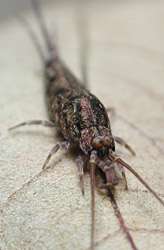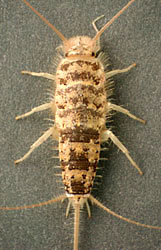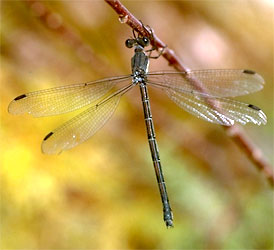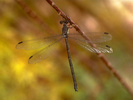Insecta
Insects



This tree diagram shows the relationships between several groups of organisms.
The root of the current tree connects the organisms featured in this tree to their containing group and the rest of the Tree of Life. The basal branching point in the tree represents the ancestor of the other groups in the tree. This ancestor diversified over time into several descendent subgroups, which are represented as internal nodes and terminal taxa to the right.

You can click on the root to travel down the Tree of Life all the way to the root of all Life, and you can click on the names of descendent subgroups to travel up the Tree of Life all the way to individual species.
For more information on ToL tree formatting, please see Interpreting the Tree or Classification. To learn more about phylogenetic trees, please visit our Phylogenetic Biology pages.
close boxCharacteristics
Insects have a large number of unique, derived characteristics, although none of these are externally obvious in most species. These include (Kristensen, 1991):
- lack of musculature beyond the first segment of antenna.
- Johnston's organ in pedicel (second segment) of antenna. This organ is a collection of sensory cells that detect movement of the flagellum.
- a transverse bar forming the posterior tentorium inside the head
- tarsi subsegmented
- females with ovipositor formed by gonapophyses from segments 8 and 9
- annulated, terminal filament extending out from end of segment 11 of abdomen (subsequently lost in most groups of insects)
Discussion of Phylogenetic Relationships
The relationships of primitively wingless insects to each other and to winged insects (pterygotes) is well established, with a few exceptions.One notable feature linking Thysanura + Pterygota is the presence of two articulations on each mandible. Archaeognathans have only one mandibular condyle or articulation point; they are "monocondylic". Thysanura + Pterygota, with their two mandibular condyles, are sometimes called Dicondylia. The many other apomorphies linking Dicondylia are described in Kristensen (1991).
It is possible that the thysanurans are not themselves monophyletic; Thysanura (exclusive of the family Lepidothricidae) plus pterygotes may be monophyletic, with lepidothricids sister to this complex (Kristensen, 1991).
References
Beutel, R. G. and S. N. Gorb. 2001. Ultrastructure of attachment specializations of hexapods, (Arthropoda): evolutionary patterns inferred from a revised ordinal phylogeny. Journal of Zoological Systematics and Evolutionary Research 39:177-207.
Bitsch, J. and A. Nel. 1999. Morphology and classification of the extinct Archaeognatha and related taxa (Hexapoda). Annales de la Société entomologique de France 35:17-29.
Boudreaux, H. B. 1979. Arthropod Phylogeny with Special Reference to Insects. New York, J. Wiley.
Carpenter, F. M. 1992. Superclass Hexapoda. Volumes 3 and 4 of Part R, Arthropoda 4 of Treatise on Invertebrate Paleontology. Boulder, Colorado, Geological Society of America.
Carpenter, F. M. and L. Burnham. 1985. The geological record of insects. Annual Review of Earth and Planetary Sciences 13:297-314.
Caterino, M. S., S. Cho, and F. A. H. Sperling. 1999. The current state of insect molecular systematics: a thriving tower of Babel. Annual Review of Entomology 45:1–54.
Chapman, R. F. 1998. The Insects: Structure and Function. Cambridge University Press, Cambridge, U.K., New York.
Daly, H. V., J. T. Doyen, and A. H. Purcell III. 1998. Introduction to Insect Biology and Diversity, 2nd edn. Oxford University Press, Oxford.
Dindall, D. L. 1990. Soil Biology Guide. New York, John Wiley & Sons.
Engel, M. S. and D. A. Grimaldi. 2004. New light shed on the oldest insect. Nature 427:627-630.
Evans, H. E. 1993. Life on a Little-Known Planet. New York, Lyons & Burford.
Gereben-Krenn, B. A. and G. Pass. 2000. Circulatory organs of abdominal appendages in primitive insects (Hexapoda : Archaeognatha, Zygentoma and Ephemeroptera). Acta Zoologica 81:285-292.
Grimaldi, D. 2001. Insect evolutionary history from Handlirsch to Hennig, and beyond. Journal of Paleontology 75:1152-1160.
Grimaldi, D. and M. S. Engel. 2005. Evolution of the Insects. Cambridge University Press.
Hennig, W. 1981. Insect Phylogeny. New York, J. Wiley.
Kjer, K. M. 2004. Aligned 18S and insect phylogeny. Systematic Biology 53(3):506-514.
Klass, K. D. 1998. The proventriculus of the Dicondylia, with comments on evolution and phylogeny in Dictyoptera and Odonata (Insecta). Zoologischer Anzeiger 237:15-42.
Kristensen, N. P. 1975. The phylogeny of hexapod "orders". A critical review of recent accounts. Zeitschrift für zoologische Systematik und Evolutionsforschung 13:1–44.
Kristensen, N. P. 1981. Phylogeny of insect orders. Annual Review of Entomology 26:135-157.
Kristensen, N. P. 1995. Forty years' insect phylogenetic systematics. Zoologische Beiträge NF 36(1):83-124.
Kukalová-Peck, J. 1987. New Carboniferous Diplura, Monura, and Thysanura, the hexapod ground plan, and the role of thoracic lobes in the origin of wings (Insecta). Canadian Journal of Zoology 65:2327-2345.
Labandeira, C. C., and J. J. Sepkoski, jr. 1993. Insect diversity in the fossil record. Science 261:310–315.
Larink, O. 1997. Apomorphic and plesiomorphic characteristics in Archaeognatha, Monura, and Zygentoma. Pedobiologia 41:3-8.
Merritt, R. W. and K. W.Cummins, eds. 1984. An Introduction to the Aquatic Insects of North America, Second Edition. Kendall-Hunt.
Naumann, I. D., P. B. Carne, J. F. Lawrence, E. S. Nielsen, J. P. Spradberry, R. W. Taylor, M. J. Whitten and M. J. Littlejohn, eds. 1991. The Insects of Australia: A Textbook for Students and Research Workers. Volume I and II. Second Edition. Carlton, Victoria, Melbourne University Press.
Pass, G. 2000. Accessory pulsatile organs: Evolutionary innovations in insects. Annual Review of Entomology 45:495-518.
Snodgrass, R. E. 1935. Principles of Insect Morphology. McGraw-Hill, New York. 667 pp.
Snodgrass, R. E. 1952. A Textbook of Arthropod Anatomy. Comstock Publishing Associates, Ithaca, N.Y. 363 pp.
Stehr, F. W. 1987. Immature Insects, vol. 1. Dubuque, Iowa: Kendal/Hunt. 754 pp.
Stehr, F. W. 1991. Immature Insects, vol. 2. Dubuque, Iowa: Kendal/Hunt. 974 pp.
Wooton, R. J. 1981. Paleozoic insects. Annual Review of Entomology 26:319-344.
Information on the Internet
- Smithsonian Institution Department of Entomology.
- Entomology Department of Harvard's Museum of Comparative Zoology
- Entomology Department. California Academy of Sciences.
- The Essig Museum of Entomology. Berkeley, California.
- Insect Division. University of Michigan Museum of Zoology.
- Bishop Museum Hawaii Entomology Home
- Introduction to Insect Biology & Classification. The University of Queensland.
- Virtual Exhibit on Canada's Biodiversity: Insects.
- Entomological Data Information System (EDIS). Staatliches Museum für Naturkunde Stuttgart, Germany.
- Compendium of Hexapod Classes and Orders. North Carolina State University.
- Nomina Insecta Nearctica. A Checklist of the Insects of North America.
- Common Names of Insects in Canada. Entomological Society of Canada.
- The Canadian National Collection (CNC) of Insects, Arachnids and Nematodes.
- Singing Insects of North America. By Thomas J. Walker (crickets and katydids) and Thomas E. Moore (cicadas).
- Entomology Database KONCHU. Species Information Database on Japanese, East Asian and Pacific Insects, Spiders and Mites.
- A Catalogue of the Insects of South Africa.
- CSIRO Entomology Home Page.
- General Entomology Resources from Scientific Reference Resources:
- Entomological Society of America.
- Chemical Ecology of Insects. John A. Byers, USDA-ARS.
- elin. Entomology Libraries and Information Networks.
- Entomological Glossary.
- Popular Classics in Entomology. Colorado State University.
- Forensic Entomology Pages, International.
- Book of Insect Records. University of Florida.
- Alien Empire. Companion piece to a PBS Nature program.
Internet directories:
- Entomology Index of Internet Resources. Iowa State University.
- Entomology on the WWW. Colorado State University.
- Entomology on the WWW. Michigan State University.
- BIOSIS BiologyBrowser: Insecta.
Images and Other Media:
- BugGuide.Net. An online community of naturalists who enjoy learning about and sharing observations of insects, spiders, and other related creatures.
- Hawaiian Insect Image Galleries. Bishop Museum.
- Entomology Image Gallery. Iowa State University.
- Very Cool Bugs.
- Dennis Kunkel's Microscopy.
- The Virtual Insectary.
- Thais in 2000: Entomology.
- Reference Library of Digitized Insect Sounds. Richard Mankin, Center for Medical, Agricultural and Veterinary Entomology, Gainesville, Florida.
Fossil Insects:
- Meganeura. Palaeoentomological Newsletter.
- Eocene Fossils.
- Fossil insects from Florissant (Colorado). Peabody Museum of Natural History.
- Stewart Valley Fossil Insects. California Academy of Sciences.
- Amber and Copal: Their Significance in the Fossil Record. Hooper Virtual Natural History Museum.
- The Natural History of Amber. 3 Dot Studio.
- Frozen Dramas. Swedish Amber Museum.
- Nature's Preservative--Organic Flypaper: Amber Gives a Green Light to Study of Ancient Life. The Why files. University of Wisconsin.
- Amber Home. Gary Platt.
- Baltic Amber Inclusions. Wolfgang Wiggers.
- Dominican Amber Fossils. ESP Designs.
- The Amber Room. Steve Kurth.
Famous entomologists:
- Thomas Say (1787-1834), father of American entomology.
- Charles Darwin (1809-1882), AboutDarwin.com.
- Jean-Henri Fabre (1823-1915) e-museum.
- Famous Entomologists on Postage Stamps.
For young entomologists:
- bugbios. Shameless promotion of insect appreciation by Dexter Sear.
- O. Orkin Insect Zoo. National Museum of Natural History. Smithsonian Institution.
- Bug Camp. Field Museum of Natural History, Chicago.
- Insectclopedia. Links to websites about insects.
- Bugscope. Educational outreach project of the World Wide Laboratory.
- The Bug Club for Young Entomologists. UK Amateur Entomologists' Society.
- The Wonderful World of Insects.
- Class: Insecta. Spencer Entomological Museum at the University of British Columbia, Vancouver, Canada.
Title Illustrations

| Scientific Name | Machilidae |
|---|---|
| Location | USA: North Carolina: Durham |
| Comments | Bristletail (Archaeognatha) |
| Specimen Condition | Live Specimen |
| Image Use |
 This media file is licensed under the Creative Commons Attribution License - Version 3.0. This media file is licensed under the Creative Commons Attribution License - Version 3.0.
|
| Copyright |
© 2004 David R. Maddison

|
| Scientific Name | Thermobia domestica |
|---|---|
| Location | Tucson, Arizona, USA |
| Comments | Silverfish (Thysanura) |
| Image Use |
 This media file is licensed under the Creative Commons Attribution License - Version 3.0. This media file is licensed under the Creative Commons Attribution License - Version 3.0.
|
| Copyright |
© 2003 David R. Maddison

|
| Scientific Name | Lestidae |
|---|---|
| Location | Zion National Park (Utah, USA) |
| Creator | Photograph by Robert Potts |
| Specimen Condition | Live Specimen |
| Source | Coenagrionidae Family; Narrow-winged Damsel Fly |
| Source Collection | CalPhotos |
| Copyright |
© California Academy of Sciences

|
About This Page
Page copyright © 2002
All Rights Reserved.
Citing this page:
Tree of Life Web Project. 2002. Insecta. Insects. Version 01 January 2002 (under construction). http://tolweb.org/Insecta/8205/2002.01.01 in The Tree of Life Web Project, http://tolweb.org/











 Go to quick links
Go to quick search
Go to navigation for this section of the ToL site
Go to detailed links for the ToL site
Go to quick links
Go to quick search
Go to navigation for this section of the ToL site
Go to detailed links for the ToL site